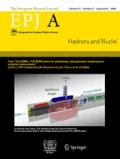Abstract.
A search for narrow \(\Theta(1540)^ + \), a candidate for pentaquark baryon with positive strangeness, has been performed in an exclusive proton-induced reaction \(p + \mathrm{C}(N)\to \Theta^ + \bar{K}^0 + \mathrm{C}(N)\) on carbon nuclei or quasifree nucleons at E beam = 70 GeV (\(\sqrt{s} = 11.5\) GeV) studying nK + , pK S 0 and pK L 0 decay channels of \(\Theta(1540)^ + \) in four different final states of the \(\Theta^ + \bar{K}^0\) system. In order to assess the quality of the identification of the final states with neutron or K 0 L , we reconstructed \(\Lambda(1520)\to nK^0_S\) and \(\phi\to K^0_LK^0_S\) decays in the calibration reactions \(p + \mathrm{C}(N)\to \Lambda(1520)K^ + + \mathrm{C}(N)\) and \(p + \mathrm{C}(N)\to p\phi + \mathrm{C}(N)\). We found no evidence for narrow pentaquark peak in any of the studied final states and decay channels. Assuming that the production characteristics of the \(\Theta^ + \bar{K^0}\) system are not drastically different from those of the \(\Lambda(1520)K^ + \) and \(p\phi\) systems, we established upper limits on the cross-section ratios \(\sigma(\Theta^ + \bar{K}^0) / \sigma(\Lambda(1520)K^ + ) < \) 0.02 and \(\sigma(\Theta^ + \bar{K}^0) / \sigma(p\phi ) < \) 0.15 at 90% CL and a preliminary upper limit for the forward hemisphere cross-section \(\sigma(\Theta^ + \bar{K}^0) < \) 30 nb/nucleon.
Similar content being viewed by others
References
LEPS Collaboration (T. Nakano et al. ), Phys. Rev. Lett. 91, 012002 (2003), hep-ex/0301020.
DIANA Collaboration (V.V. Barmin et al. ), Phys. At. Nucl. 66, 1715 (2003) (Yad. Fiz. 66, 1763 (2003)), hep-ex/0304040.
CLAS Collaboration (S. Stepanyan et al. ), Phys. Rev. Lett. 91, 252001 (2003), hep-ex/0307018.
SAPHIR Collaboration (J. Barth et al. ), hep-ex/0307083.
A.E. Asratyan, A.G. Dolgolenko, M.A. Kubantsev, hep-ex/0309042.
CLAS Collaboration (V. Kubarovsky et al. ), Phys. Rev. Lett. 92, 032001 (2004); 92, 049902 (2004)(E), hep-ex/0311046.
R. Togoo et al. , Proc. Mong. Acad. Sci. 4, 2 (2003).
HERMES Collaboration (A. Airapetian et al. ), Phys. Lett. B 585, 213 (2004), hep-ex/0312044.
SVD Collaboration (A. Aleev et al. ), hep-ex/0401024.
COSY-TOF Collaboration (M. Abdel-Bary et al. ), hep-ex/0403011.
P.Z. Aslanyan, V.N. Emelyanenko, G.G. Rikhkvitzkaya, hep-ex/0403044.
ZEUS Collaboration (S. Chekanov et al. ), hep-ex/0403051.
A.R. Dzierba, D. Krop, M. Swat, S. Teige, A.P. Szczepaniak, Phys. Rev. D 69, 051901 (2004), hep-ph/0311125.
J.L. Rosner, Phys. Rev. D 69, 094014 (2004), hep-ph/0312269.
M. Zavertyaev, hep-ph/0311250.
Q. Zhao, F.E. Close, hep-ph/0404075.
E. Klempt, hep-ph/0404270.
BES Collaboration (J.Z. Bai et al. ), hep-ex/0402012.
HERA-B Collaboration (K.T. Knopfle, M. Zavertyaev, T. Zivko), hep-ex/0403020.
C. Pinkenburg (for the PHENIX Collaboration, nucl-ex/0404001.
P. Hansen (for ALEPH Collaboration), talk at DIS 2004, http://www.saske.sk/dis04/talks/C/hansen.pdf.
Throsten Wengler (reporting DELPHI Collaboration results), talk at Moriond ‘04 QCD, http://moriond.in2p3. fr/QCD/2004/WednesdayAfternoon/Wengler.pdf.
M. Karliner, H.J. Lipkin, hep-ph/0405002.
SPHINX Collaboration (M.Y. Balats et al. ), Z. Phys. C 61, 223 (1994); SPHINX Collaboration (V.A. Dorofeev et al. ), Phys. At. Nucl. 57, 227 (1994) (Yad. Fiz. 57, 241 (1994)).
SPHINX Collaboration (D.V. Vavilov et al. ), Phys. At. Nucl. 57, 1970 (1994) (Yad. Fiz. 57, 2046 (1994)).
SPHINX Collaboration (M.Y. Balats et al. ), Z. Phys. C 61, 399 (1994).
SPHINX Collaboration (S.V. Golovkin et al. ), Eur. Phys. J. A 5, 409 (1999).
SPHINX Collaboration (D.V. Vavilov et al. ), Phys. At. Nucl. 63, 1391 (2000) (Yad. Fiz. 63, 1469 (2000).
L.G. Landsberg, Phys. Rep. 320, 223 (1999).
SPHINX Collaboration (Y.M. Antipov et al. ), Phys. At. Nucl. 65, 2070 (2002) (Yad. Fiz. 65, 2131 (2002).
D. Diakonov, V. Petrov, M.V. Polyakov, Z. Phys. A 359, 305 (1997), hep-ph/9703373.
H. Weigel, Eur. Phys. J. A 2, 391 (1998), hep-ph/9804260.
Y. Antipov et al. , Nucl. Phys. Proc. Suppl. 44, 206 (1995).
A. Kozhevnikov, V. Kubarovsky, V. Molchanov, V. Rykalin, V. Solyanik, Nucl. Instrum. Methods A 433, 164 (1999).
CERN-Heidelberg-Padua-Paris-Rome-Serpukhov-Trieste Collaboration (B. Powell et al. ), Nucl. Instrum. Methods 198, 217 (1982).
Y.M. Antipov et al. , Nucl. Instrum. Methods A 295, 81 (1990).
S.I. Bityukov et al. , IFVE-94-101.
Particle Data Group Collaboration (K. Hagiwara et al. ), Phys. Rev. D 66, 010001 (2002).
M.W. Arenton, D.S. Ayres, R. Diebold, E.N. May, L. Nodulman, J.R. Sauer, A.B. Wicklund, Phys. Rev. D 25, 22 (1982).
SPHINX Collaboration (S.V. Golovkin et al. ), Z. Phys. A 359, 435 (1997).
V.R. Krastev et al. , JINR-P1-88-31.
R.E. Ansorge, J.R. Carter, J.A. Charlesworth, W.W. Neale, J.G. Rushbrooke, Phys. Rev. D 10, 32 (1974).
W. Liu, C.M. Ko, Phys. Rev. C 68, 045203 (2003), nucl-th/0308034.
S. Nussinov, hep-ph/0307357; R.W. Gothe, S. Nussinov, hep-ph/0308230; R.A. Arndt, I.I. Strakovsky, R.L. Workman, Phys. Rev. C 68, 042201 (2003), nucl-th/0308012, nucl-th/0311030; J. Haidenbauer, G. Krein, hep-ph/0309243; R.N. Cahn, G.H. Trilling, hep-ph/0311245; A. Casher, S. Nussinov, Phys. Lett. B 578, 124 (2004), hep-ph/0309208; A. Sibirtsev, J. Haidenbauer, S. Krewald, U.G. Meissner, hep-ph/0405099.
D. Christian, E690 Collaboration, Quarks and Nuclear Physics 2004, Bloomington, Indiana, May 23-28, 2004, http://www.qnp2004.org/.
Author information
Consortia
Additional information
Communicated by V.V. Anisovich
Received: 16 July 2004, Published online: 21 September 2004
PACS:
12.39.Mk Glueball and nonstandard multi-quark/gluon states - 13.85.Rm Limits on production of particles - 14.20.-c Baryons (including antiparticles) - 25.40.-h Nucleon-induced reactions
Rights and permissions
About this article
Cite this article
The SPHINX Collaboration. Search for \({\rm\Theta}(1540)^ + \) in the exclusive proton-induced reaction \({\rm p + {C(N)\to \Theta^ + \bar{K}^0 + {C}(N)}}\) at the energy of 70 GeV. Eur. Phys. J. A 21, 455–468 (2004). https://doi.org/10.1140/epja/i2004-10062-4
Issue Date:
DOI: https://doi.org/10.1140/epja/i2004-10062-4




